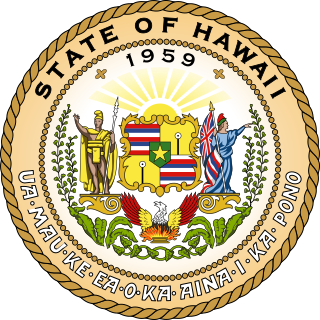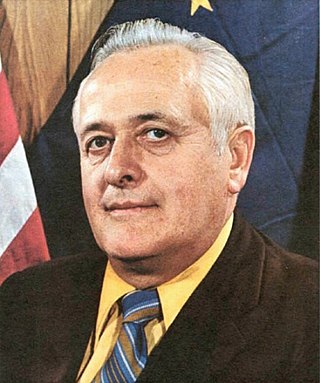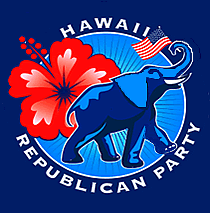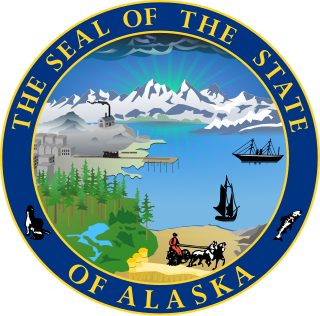
Since Hawaii became a state in 1959, it has sent congressional delegations to the United States Senate and United States House of Representatives. Each state elects two senators to serve for six years. Members of the House of Representatives are elected to two-year terms, one from each of Hawaii's congressional districts. Before becoming a state, the Territory of Hawaii elected a non-voting delegate at-large to Congress from 1900 to 1958.

The Hawaii State Legislature is the bicameral state legislature of the U.S. state of Hawaii, consisting of the Hawaii State Senate and the Hawaii State House of Representatives. Each lawmaker represents single member districts across the state. The powers of the legislature are granted under Article III of the Constitution of Hawaii. The legislature convenes at the Hawaii State Capitol building in the state capital of Honolulu, on the island of Oahu.

The Territory of Hawaii or Hawaii Territory was an organized incorporated territory of the United States that existed from April 30, 1900, until August 21, 1959, when most of its territory, excluding Palmyra Island, was admitted to the United States as the 50th US state, the State of Hawaii. The Hawaii Admission Act specified that the State of Hawaii would not include Palmyra Island, the Midway Islands, Kingman Reef, and Johnston Atoll, which includes Johnston Island and Sand Island.

William Allen Egan was an American Democratic politician. He served as the first governor of the State of Alaska from January 3, 1959, to 1966 and 1970 to 1974, as well as a shadow U.S. Senator from Alaska Territory from 1956 to 1959. Born in Valdez, Alaska, Egan is one of only two governors in the state's history to have been born in Alaska. He was the Democratic nominee in the first five gubernatorial elections.

William Francis QuinnOESSH was an American lawyer and politician who served as the 12th and last governor of the Territory of Hawaii from 1957 to 1959 and the first governor of the State of Hawaii from 1959 to 1962. Originally appointed to the office by President Dwight D. Eisenhower, Quinn was the last executive appointed by an American president, after American rule of the Hawaiian Islands began after the overthrow of the monarchy in 1893. He was also the last Republican to serve as governor until Linda Lingle in 2002. Quinn appeared as a guest on the television program What's My Line. He was the recipient of the Order of the Holy Sepulchre, a papal knighthood conferred by Pope John Paul II. He was the state's first Republican governor.

Nelson Kiyoshi Doi, was the sixth lieutenant governor of Hawaii from 1974 to 1978 in the first elected administration of Governor George Ariyoshi. Doi was a member of the Hawaii Democratic Party.

James Kimo Kealoha was an American politician who served as the first lieutenant governor of Hawaii in the administration of Governor of Hawaiʻi William F. Quinn. Prior to his election as Lieutenant Governor, Kealoha served a number of years as a legislator on Hawaii island, distinguishing himself as a respected leader.

The Admission Act, formally An Act to Provide for the Admission of the State of Hawaii into the Union is a statute enacted by the United States Congress and signed into law by President Dwight D. Eisenhower which dissolved the Territory of Hawaii and established the State of Hawaii as the 50th state to be admitted into the Union. Statehood became effective on August 21, 1959. Hawaii remains the most recent state to join the United States.

The Hawaii Republican Party is the affiliate of the Republican Party (GOP) in Hawaii, headquartered in Honolulu. The party was strong during Hawaii's territorial days, but following the Hawaii Democratic Revolution of 1954 the Democratic Party came to dominate Hawaii. The party currently has little power and is the weakest state affiliate of the national Republican Party; it controls none of Hawaii's statewide or federal elected offices and has the least presence in the state legislature of any state Republican party.

The Alaska Statehood Act was a legislative act introduced by Delegate E. L. "Bob" Bartlett and signed by President Dwight D. Eisenhower on July 7, 1958. Through it, Alaska became the 49th U.S. state on January 3, 1959. The law was the culmination of a multi-decade effort by many prominent Alaskans, including Bartlett, Ernest Gruening, Bill Egan, Bob Atwood, and Ted Stevens.

The number of elections in Alaska varies by year, but typically municipal elections occur every year, plus primary and general elections for federal and state offices occur during even-numbered years. Alaska has a gubernatorial election every four years. Members of the state's United States congressional delegation run for election or re-election at the times set out in the United States Constitution. Primary elections assist in choosing political parties' nominees for various positions. On a regional basis, elections also cover municipal issues. In addition, a special election can occur at any time.

Elections in Hawaii are held for various local, state, and federal seats in the state of Hawaii. Regular elections are held every even year, although special elections may be held to fill vacancies at other points in time. The primary election is held on the second Saturday in August, while the general election is held on Election Day, which is the first Tuesday after the first Monday in November.

The 2012 United States elections took place on November 6, 2012. Democratic President Barack Obama won reelection to a second term and the Democrats gained seats in both chambers of Congress, retaining control of the Senate even though the Republican Party retained control of the House of Representatives. As of 2024, this is the most recent election cycle in which neither the presidency nor a chamber of Congress changed partisan control, and the last time that the party that won the presidency simultaneously gained seats in both the House of Representatives and the Senate.

The Hawaii Democratic Revolution of 1954 is a popular term for the territorial elections of 1954 in which the long dominance of the Hawaii Republican Party in the legislature came to an abrupt end, replaced by the Democratic Party of Hawaii which has remained dominant since. The shift was preceded by general strikes, protests, and other acts of civil disobedience that took place in the Hawaiian Archipelago. The strikes by the Isles' labor workers demanded similar pay and benefits to their Mainland counterparts. The strikes also crippled the power of the sugarcane plantations and the Big Five Oligopoly over their workers.

The Puerto Rico statehood movement aims to make Puerto Rico a state of the United States. Puerto Rico is an unincorporated territorial possession of the United States acquired in 1898 following the Spanish–American War, making it "the oldest colony in the modern world". As of 2023, the population of Puerto Rico is 3.2 million, around half the average state population and higher than that of 19 U.S. states. Statehood is one of several competing options for the future political status of Puerto Rico, including: maintaining its current status, becoming fully independent, or becoming a freely associated state. Puerto Rico has held seven referendums on the topic since 1967, and four since 2012. They are non-binding, as the power to grant statehood lies with the US Congress.

The 1962 Hawaii gubernatorial election was Hawaii's second gubernatorial election. The election was held on November 6, 1962, and resulted in a victory for the Democratic candidate, former Territorial Delegate John A. Burns over Republican William F. Quinn, the incumbent Governor of Hawaii. The election was a rematch between the candidates of the previous election, with the outcome reversed. Burns received more votes than Quinn in every county in the state.

The 1959 United States Senate elections in Hawaii were held July 28, 1959. Following the admission of Hawaii as the 50th State in the union, the state held 2 simultaneous elections to determine its first senators.

Nancy Ellen Quinn was an American public figure, former First Lady of Hawaii, and a prominent figure during Hawaii's transition to statehood. Quinn, the wife of Governor William F. Quinn, served as the last First Lady of the Territory of Hawaii from 1957 until 1959. She then served as the first First Lady of the new U.S. state of Hawaii from 1959 to 1962. According to Time Magazine, Nancy Quinn was the first person in the Territory of Hawaii to receive news that the bill granting Hawaiian statehood had been signed by President Dwight Eisenhower in 1959.

The 1876 Colorado gubernatorial election took place on October 3, 1876, to elect the 1st Governor of Colorado after the state was admitted to the union on August 1, 1876. Republican John Long Routt, last governor of the Colorado Territory, was elected in a close race against Democratic nominee Bela M. Hughes.

A referendum of the status of Puerto Rico was held on November 3, 2020, concurrently with the general election. The Referendum was announced by Puerto Rico Governor Wanda Vázquez Garced on May 16, 2020. This was the sixth referendum held on the status of Puerto Rico, with the previous one having taken place in 2017. This was the first referendum with a simple yes-or-no question, with voters having the option of voting for or against becoming a U.S. state. The New Progressive Party (PNP), of whom Vázquez is a member, supports statehood, while the opposition Popular Democratic Party (PDP) and Puerto Rican Independence Party (PIP) oppose it.





















